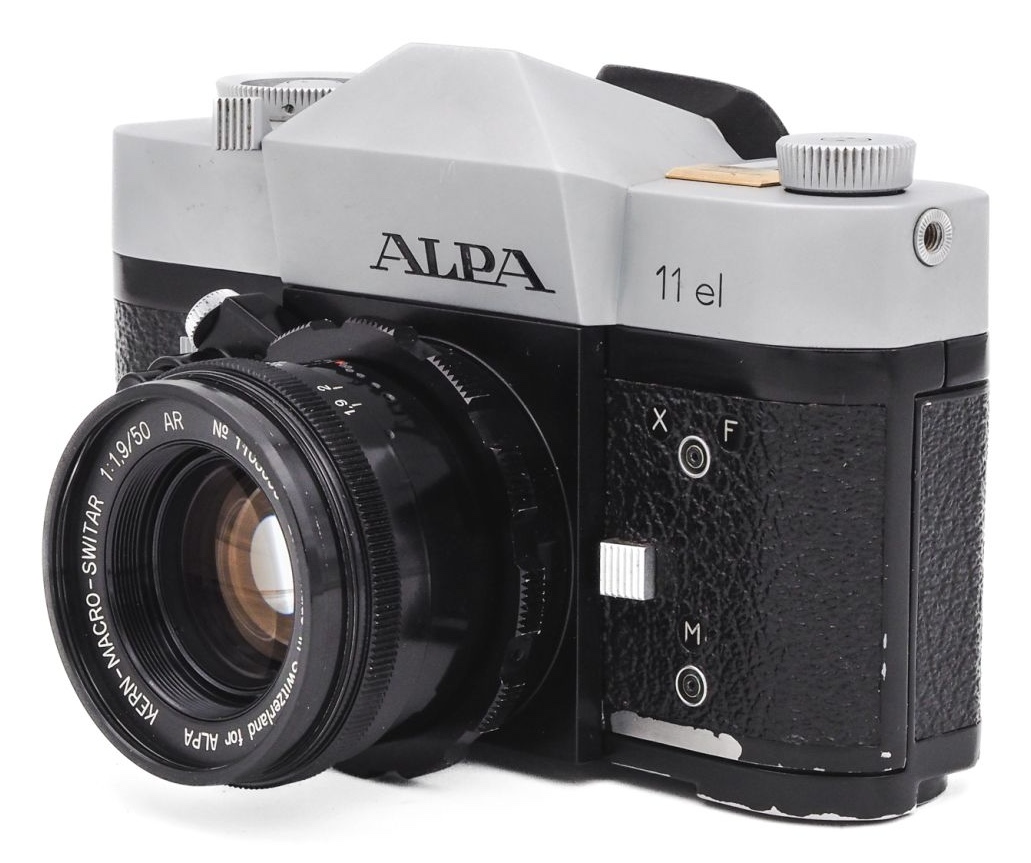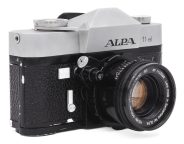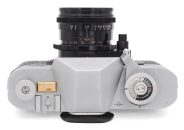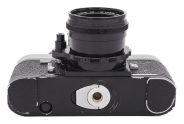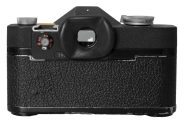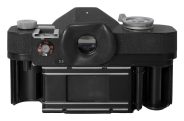Alpa 11 el
35mm MF film SLR camera • Collectible
Specification
| Production details: | |
| Announced: | 1973 |
| Production type: | Small-batch production |
| System: | ● Alpa (1952) |
| Format: | |
| Maximum format: | 35mm full frame |
| Film type: | 135 cartridge-loaded film |
| Mount and Flange focal distance: | Alpa [37.8mm] |
| Shutter: | |
| Type: | Focal-plane |
| Model: | Mechanical |
| Speeds: | 1 - 1/1000 + B |
| Exposure: | |
| Exposure metering: | Through-the-lens (TTL), stop-down |
| Exposure modes: | Manual |
| Physical characteristics: | |
| Weight: | 725g |
| Dimensions: | 148x94x49.5mm |
Manufacturer description #1
Shockproof, solid state electronic light-matching meter with 6 transistors, 3 CdS cells, 3-way meter and shutter lock, red arrow for under, yellow arrow for over exposure, giving more precise and more sensitive readings and eliminating most repairs.
Transistored: Electronic lightmeter with 6 transistors (instead of galvanometer).
Ideally center-weighted: 2 CdS cells take overall readings, 3rd CdS cell compensates for light entering eyepiece, electronically computing precise exposure.
Logical: Illuminated small red arrow indicates under exposures, illuminated large yellow arrow indicates over exposures.
Convenient: Arrows are visible both inside below groundglass AND outside on top of ALPA, in accessory clip window with protective cover.
Sensitive: Reacts to slightest changes of light, direction, focus, etc. (3-6400 ASA).
Faster, easier: Arrows indicate either left or right turn of diaphragm of standard 50mm f/l.9 Xenon or Macro-Switar APOCHROMAT, OR of speed knob, for correct exposures.
More precise: Simultaneous illumination of both red and yellow arrows (instead of quivering needle), gives absolutely precise readings up to 1/10 of an f/stop.
Available light photography: Illuminated arrows are always visible, light up even under poorest light conditions.
Shockproof: Solid state, transistorized electronic circuit (instead of delicate galvanometer and needle) withstands the most rugged use; eliminates most repairs.
Longlasting: PX 28 standard 6 Volt leakproof, longlife silver oxide battery suited for extreme temperatures, is only used for light readings, lasts up to 2 years.
Auto-battery test: Illuminated arrows automatically indicate that battery operates.
Time exposure: Right, locked position, also provides time exposure (T).
Brightest image in 1:1 LIFE size: Combination of precision ground prism, finest grain groundglass and large, coated mirror offers strikingly brilliant image, in 1:1 LIFE size.
ALL-IN-ONE screen with 4-way choice: For any lens, any object, any distance, any light condition, any person, any type of photography - without lengthy and complicated changing of screens:
a) Brilliant groundglass for easy composition, focusing, and depth-of-field control, with cross-hair calibrated in mm for comparing dimensions;
b) 45° diagonal split-image rangefinder, for instant line-up on vertical or horizontal lines;
c) Very bright micro-prism collar for pinpoint accuracy;
d) Clear glass collar offers aerial image, for instant viewing of subject, extreme close-ups and photomicrography.
Special groundglasses are available on request.
Mirror lock: Mirror can be lifted to eliminate vibration with extreme telephoto lenses, for ultra close-ups, photomicrography, etc.
Precise double, or multiple exposures: Film does not advance at all for intentional double, triple, quadruple, quintuple exposures, etc.
Choice of finish: Chrome, black-chrome, or black finish with 24 Karat goldplated top, plus black or attractive dark green, red, blue, grey, rosewood or reptile covering.
Solid diecast body, precision mechanism: Unbendable, virtually indestructible, yet lightweight, compact diecast body (no punched-out sheet metal) with sturdy swiss precision mechanism, withstands the most rugged use, for lifelong durability.
100% Quality controls, World-wide warranty: Custom-built in Switzerland for you, limited production geared to the most rigid precision standards, 100% quality controls, world-wide warranty, for highest mechanical, electronic and optical performance.
LIMITED PRECISION PRODUCTION - UNLIMITED SYSTEM OF PHOTOGRAPHY
The shockproof solid state electronic light-matching meter of the ALPA 11el provides absolutely precise, optical through-the-lens readings up to 1/10, of an f/stop with
- Electronically tested Swiss precision shutter for film ratings from 3-6400 ASA, speeds from 1-1/1000 second, with intermediate settings, plus B and T, selftimer, X and M synchronization.
- Macro-Switar 50mm f/1.9 ALL-IN-ONE AUTO-APOCHROMAT with 8 elements, a unique combination of wide aperture, critical sharpness, APOCHROMATIC correction with precise color fidelity, and focusing from infinity to 7" (1:3), without any accessories, in ONE standard lens.
- More than 35 top quality ALPA lenses, from 360 ultra wide angle up to 5000mm super telephoto, including 8 unrivaled APOCHROMATS, all unconditionally guaranteed for optical excellence.
- More than 1000 adaptable lenses: Exacta, Leica, Leicaflex, Nikon, Pentax, Rolleiflex, T-mount, etc., all with infinity focusing, and with auto-adapters even automatic diaphragm control.
- Special Macro-lenses, bellows, extension tubes, lens inversion rings, etc. offering a continuous focusing range from infinity all the way down to ultra close-ups of 1:10 - 1:1 - 20:1 - (with microscope) 1500:1x magnification, without any gap.
- 100 ft. back, electric motor, half (single) frame cameras 18x24mm or 17x22.5mm (filmstrip format), for uninterrupted sequences up to 800 full frames or 1600 half frames (with thin base film 1200 or 2400 frames), with optional spacing accuracy of 0.38mm or with pin registration of 100 ft. back an incredible 0.02mm.
Manufacturer description #2
The ALPA 11 el and the unlimited ALPA system of photography are the results of more than 30 years of research and development to meet the evergrowing demands of the creative photographer, as well as of scientific and industrial photography.
The Swiss ALPA 11 el is a 35 mm single-lens reflex camera (24 x 36 mm, 18 x 24 mm or 17 x 22.5 mm) with through-the-lens light matching meter. The precise, shockproof solid state electronic circuit has six transistors, a yellow light for over and a red light for under exposure, visible both below the groundglass and on top of the ALPA.
Replacing the delicate galvanometer with quivering needle, this shockproof meter gives you easier, faster, more sensitive and far more precise exposures - up to 1/10th of an f/stop - and eliminates most meter repairs.
The meter system has a very wide range of sensitivity (1.6 - 400,000 asb). Current is supplied by one Mallory PX 28 battery (Eveready 544).
The transistorized circuit receives information from two Cds cells which measure the light coming through the lens, while a third cell compensates for any stray light entering the system through the viewfinder. The electronic circuit lights the lamps: yellow indicates overexposure, red underexposure. When both lamps are lit at once, exposure is correct. The two cells integrate readings from the screen, with center weighting, to give highly accurate exposure control.
The ALPA body is a light-weight, compact die-cast of great strength and long-lasting rigidity. The ALPA 11 el has a pentaprism for eye level viewing, and an instant-return mirror which reacts even if the shutter release is kept depressed. Any slight vibration accompanying the return occurs only after the exposure is completed, and cannot affect the sharpness of the picture. A film-type reminder is on the back of the camera.
All controls are easily accessible and can be operated even if wearing gloves.
Every feature has been planned for fool-proof operation.
Manufacturer description #3
Single-lens reflex 24 x 36 mm; lightweight rigid pressure-cast body; through-the-lens integrated light-metering using three CdS cells; illuminated exposure-indicators visible in viewfinder and on the body; sliding cover for indicators on body; speeds and apertures internally coupled; speeds from 3 to 6400 ASA can be set; unique circuit switch for light measurements; focal-plane shutter of rubberised fabric running on ball-bearings; range of speeds from 1 to 1/1000 sec and B; self-timer with delay up to 18 secs; X-F and M synchronisation; standard screen with split-image rangefinder and microprisms; special screens to order; special formats supplied to order; instant-return mirror covering entire field even with long focal lengths and at long extensions; mirror-release button, especially useful for superimposition; 3-position button: release alone - release with metering - metering alone; rapid rewind with large retractable lever; progressive frame counter; ALPA lens bayonet mount (allows practically all other makes of lens to be used with the ALPA); battery (1 only) Eveready 544 or Mallory PX 28.
From the editor
Similar to the 10 d, but with the light matching meter: yellow lamp indicates overexposure, red underexposure. When both lamps are lit, exposure is correct. With the 11 e, the exposure is correct when both lamps are off. This was the only difference between the 11 el and 11 e.
The 11 el was available in chrome, black or gold (24 Karat gold plated) finish, with dark green, dark red, dark blue, grey, reptile or rosewood covering.
